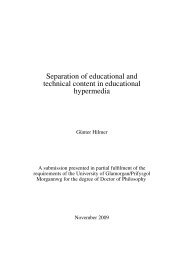framework for the implementation of a virtual design studio model in ...
framework for the implementation of a virtual design studio model in ...
framework for the implementation of a virtual design studio model in ...
You also want an ePaper? Increase the reach of your titles
YUMPU automatically turns print PDFs into web optimized ePapers that Google loves.
Appendix C<br />
l. Exploratory survey at <strong>the</strong> UAEU<br />
There are two computer labs at <strong>the</strong> Male campus. The first lab is equipped with twelve<br />
Pentium IV IBM Net Vista computers. The second lab is equipped with seven Pentium III<br />
IBM 300GL computers and four Pentium IV IBM Net vista computers. The lab also has<br />
three IBM 300PL Pentium II computers. The first lab is also equipped with one 9600<br />
power Mac<strong>in</strong>tosh and one P IV Dell tower.<br />
The second lab on <strong>the</strong> o<strong>the</strong>r hand is equipped with one PIII Compaq desk pro, and <strong>the</strong>re<br />
is also a lab-server with one high speed P III IBM Net Vista. There is also one lab <strong>in</strong> <strong>the</strong><br />
women’s campus that consists <strong>of</strong> twelve PIV IBM Net Vista and seventeen PIII IBM Net<br />
Vista. The lab also conta<strong>in</strong>s n<strong>in</strong>e PIII IBM PC300GL and one PIII Compaq Deskpro.<br />
The women's lab also conta<strong>in</strong>s two HP laser pr<strong>in</strong>ters, one canon pr<strong>in</strong>ter, one HP scanner<br />
scan jet, one HP plotter and one Infocus LCD projector. The males' lab is also equipped<br />
with one HP Plotter Design Jet, HP laser pr<strong>in</strong>ter and HP Scan Jet.<br />
CAVE is abbreviation <strong>of</strong> Computer Animated Virtual Environment. The CAVE is<br />
considered to be <strong>the</strong> most advanced and sophisticated technology <strong>in</strong> apply<strong>in</strong>g <strong>the</strong> <strong>virtual</strong><br />
reality techniques <strong>in</strong> architecture and <strong>design</strong>.<br />
The <strong>in</strong>vestigation started with draw<strong>in</strong>g a random sample <strong>of</strong> twelve students from <strong>the</strong><br />
class list <strong>of</strong> each <strong>of</strong> <strong>the</strong> five cohorts <strong>in</strong> <strong>the</strong> architecture school. An equal number <strong>of</strong><br />
students was selected from each <strong>of</strong> <strong>the</strong> male and female campuses. A prelim<strong>in</strong>ary<br />
meet<strong>in</strong>g was held with each <strong>of</strong> <strong>the</strong> male and female students separately. In this<br />
meet<strong>in</strong>g, <strong>the</strong> researcher <strong>in</strong><strong>for</strong>med <strong>the</strong> students <strong>of</strong> <strong>the</strong> purpose <strong>of</strong> her research and told<br />
<strong>the</strong>m that she needs to collect <strong>in</strong><strong>for</strong>mation about <strong>the</strong>ir perceptions <strong>of</strong> <strong>the</strong> teach<strong>in</strong>g and<br />
learn<strong>in</strong>g practices <strong>in</strong> <strong>the</strong> <strong>design</strong> courses. She, <strong>the</strong>n, expla<strong>in</strong>ed <strong>the</strong> procedure that will be<br />
followed and <strong>the</strong> time <strong>the</strong>y need to devote to this work. The researcher also assured<br />
<strong>the</strong>m that <strong>the</strong> collected <strong>in</strong><strong>for</strong>mation will be confidential and participation is voluntary.<br />
Small pieces <strong>of</strong> paper were <strong>the</strong>n distributed <strong>in</strong> which each student wrote his/her name<br />
and <strong>in</strong>dicated whe<strong>the</strong>r he/she was will<strong>in</strong>g to participate. Only one male student from<br />
<strong>the</strong> first year cohort and one female from <strong>the</strong> third year cohort <strong>in</strong>dicated <strong>the</strong>y were not<br />
will<strong>in</strong>g to participate. Both <strong>of</strong> <strong>the</strong>m <strong>in</strong>dicated that <strong>the</strong>y could not devote <strong>the</strong> time<br />
needed because <strong>of</strong> personal reasons. The two students were replaced with randomly<br />
selected colleagues.<br />
Prior to <strong>the</strong> focus group meet<strong>in</strong>gs, <strong>the</strong> researcher prepared an <strong>in</strong>terview guide, <strong>the</strong><br />
questions <strong>of</strong> which flowed from <strong>the</strong> general to <strong>the</strong> specific. However, this guide was not<br />
<strong>in</strong>tended to be faithfully followed. The researcher decided to refra<strong>in</strong> from <strong>in</strong>terfer<strong>in</strong>g if<br />
<strong>the</strong> general question was sufficient to lead <strong>the</strong> students to cover all <strong>the</strong> aspects <strong>of</strong> <strong>the</strong><br />
<strong>in</strong><strong>for</strong>mation needed. The questions were meant to be used as triggers when needed,<br />
and to turn <strong>the</strong> students back to <strong>the</strong> issues under consideration when <strong>the</strong> conversation<br />
strays away from <strong>the</strong>se issues. The researcher also decided from <strong>the</strong> outset that she will<br />
83



